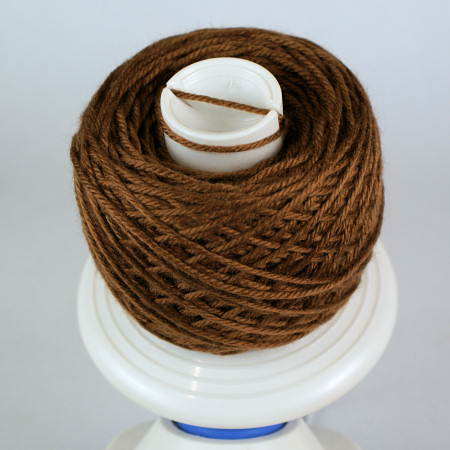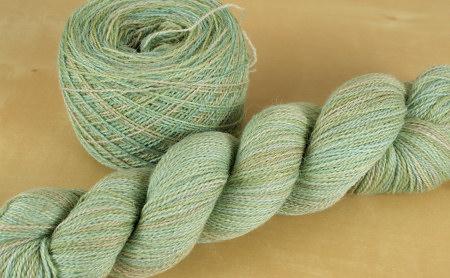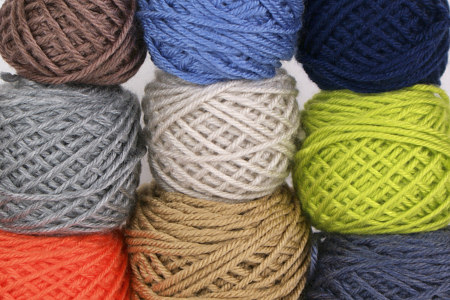I love my yarn ball winder! Not everyone already has (or even knows about) this useful tool, so I thought I’d share today why I find it so useful in my crocheting life, and whether getting one may help you too.
How to Use a Ball Winder
A yarn ball winder is a simple mechanical tool for quickly winding yarn into a neat ball.
To use, it, load one end of your yarn through the metal guide arm and across the slots at the top of the cone, then turn the handle and the yarn will wind onto the cone (see my photos near the end of this post for examples). When you’ve finished, tie the final end of the yarn around a couple of strands on the outside of the yarn ball so it doesn’t come undone, then pull the ‘cake’ of yarn off the cone.

The finished ‘cake’ isn’t shaped like a hand-wound ball, but has a flat top and bottom (which makes it easy to stack and store). And the starting end of the ball (that ran across the slots at the top of the cone) is ready to be used. Pulling the yarn from the centre of the ball instead of the outside means the ball won’t roll around while you work.
My ball winder is like this one (amazon link) but there are other similar models also available on amazon and at yarn/craft shops (e.g. the KnitPicks ball winder is a popular less expensive option). I’d recommend you check reviews before you buy one, but, for what it’s worth, I’ve never had any problems with mine – it runs smoothly and quietly.
Why I Use It
A yarn ball winder is invaluable for turning a hank of yarn into a beautiful centre-pull ball. (This is especially easy if you have a yarn swift to hold the yarn for you while you wind it, but, if you don’t have one you can ask a helper to hold the loop of yarn from the hank taut between their hands while you wind it.) When I used to buy a big hank of laceweight yarn to make a shawl, it’d take me literally hours (and many tangles) to wind all the yarn by hand. Now it takes me mere minutes to wind 400m of yarn ready for use.

A hank of yarn (front) and a centre-pull ball (back)
But that’s not the only use I have for my winder; it’s really useful for my amigurumi yarn too! Once I’ve used over half a skein of worsted weight yarn, the remainder doesn’t hold together well any more. If you store it in that state it can tangle easily, and if you store lots of partial skeins together, you could end up with a giant yarn mess that takes hours to untangle. (I’m speaking from personal experience, here…)
Since getting my ball winder, I re-wind all my partially-used skeins of yarn into tidy small balls. They stack more neatly in my drawers, and don’t get tangled any more! In case you’re wondering, I need all these leftovers for my amigurumi projects – you never know when you might need just a few metres of an unusual colour to make a specific thing, so I never throw away any yarn over a couple of metres long (and btw I even save the shorter lengths too, to make pom-poms – nothing goes to waste in my studio).

Partial skeins wound into neat balls
My Special Trick
I do something extra when I wind yarn balls that makes a huge difference to my crocheting experience. I’ve never seen it mentioned anywhere else, so I thought I should share it with you: I like to wind each ball twice.
As soon as the ball is complete, I remove it from the winder and sit it on the table next to the winder, then reattach the end from the centre of the wound ball to the winder and re-wind it into a new ball, letting the yarn flow through my fingers with a light tension as I wind it.
As you can see, the first winding looks fine, until you compare it with the result of the second winding:

The same hank of yarn, wound twice: the first winding is tiny compared with the second!
Why does this happen?
Let’s compare what happens during the first and second windings:
With the first winding, the tension on the yarn can be uneven as the yarn tugs on the swift to move it, or the skein flips about on the floor as it unwinds, or the fibres of two strands of yarn are slightly stuck together and it takes more force from the winder to pull them apart.

First winding: partial shop-bought skein to centre-pull ball
With the second winding, the yarn comes from a centre-pull ball, so it winds very regularly, as nothing is moving apart from the strand being wound. As the yarn has only just been wound into the first ball, any loose fibre ends haven’t had a chance to snarl together, so the tension on the yarn is low and steady as you wind it.

Second winding: centre-pull ball to lower tension centre-pull ball
Why does it matter?
If you keep your balled yarn wound tightly:
- The yarn is kept in a stretched state, which will affect your gauge when you crochet or knit with it.
- There’s more chance of the yarn strands sticking together into a clump – this is especially likely to happen with a yarn like mohair or alpaca, where the loose fibre ends along the yarn (visible as a fluffy halo) can grab onto each other. When you pull on the centre yarn end, a clump of yarn strands can come out together from the ball instead of one single strand, or, even worse, the yarn may not come out at all!
- The longer you keep the ball wound like this, the worse the stretching and tangling can become.
The second winding is actually much more fun to do as it winds so smoothly, so it adds very little time to the process. And what’s a couple of extra minutes of winding time compared with the many hours you’ll spend using the yarn?
In my opinion, it’s definitely worth winding your yarn twice: the result is an ideal yarn ball with neat low-tension wraps that put no stress on the yarn. You can keep your yarn wound in this ball for a long time without having to worry that it will become stretched out or will be snarled up when you try to use it.
Verdict
If you crochet or knit and don’t already own a ball winder, I’d highly recommend you pick one up, or at least put it on your wishlist. It’s time-saving, and fun to use. Even if you don’t buy yarn in hanks, it makes a huge difference in keeping the partial balls of any type of yarn in your stash tidy and organised.
If you already have a ball winder, please feel free to add your experience and tips in the comments below 🙂
















Charlotte Kidwell said
I’m glad you’re in Canada…. Even though I’m not a Canadian and live in the hottest part of the US (Phoenix, Arizona, I’m still glad you’re in the chilly north of North America (brrr) lol.
I love your blog and be been a big fan of Planet June for quite a while! I also really like your You Tube videos!
To get to the point, I’ve been researching yarn ball winders for a while now and had just about decided to buy the Stanwood model that you own. Your review has helped me make my decision. I’ll be winding every bit of yarn that I can find!
I also saw a comment on another blog where a blog reader suggested winding the yarn twice. She said the resulting yarn cake was much more nicely wound, flowed better from the cake, and the cakes kept their shape longer. Also, she said that the second winding wasn’t quite as tight as the first one and prevented over-stretching the yarn. Just a thought.
Thank you again for all the work and effort you devote to creating your designs and for sharing your extensive knowledge with us. You are very much appreciated!
June said
I do actually discuss winding the yarn twice in the above post, Charlotte. It’s something I’ve done for many years, and I definitely recommend you try it when you receive your new winder. I’m sure you’ll enjoy having and using your ball winder – I wouldn’t be without mine!
Charlotte Kidwell said
Yes, June, after I posted my comment I realized that it was you who recommended rewinding cakes of yarn, and I felt a bit embarrassed. However, it was too late as my comment was already posted! I may have forgotten that it was you who gave us this tip (sorry!), but at least I remembered the recommendation! I will definitely do this with my yarn cakes. I just recently ordered your book, “The Complete Idiot’s Guide to Amigurumi: Hook Your Way to a Fun New Hobby”, and I can’t wait to receive it! Thank you for all of the help you give to us! It’s invaluable.
Alicia Brink said
I’m now wondering how I lived without a ball winder for so many years! Thanks for the article and for all the tips people have added in.
karen mentzer said
I bought a winder and find it fun making the cakes. I then recieved a knitting machine and some books and another fancier winder. I LOVE it I will wind 2 yarns together as when I loom knit and then my sister gave me several cones of very thin yarn and am in the process of caking them. And to tack down the loose end I take my latchhook and push it under several layers and pull the yarn back through and it is secure.
June said
Oh, that’s another great tip, Karen – thank you! I’ll definitely give that a try in future.
Carol W said
I absolutely LOVE my ball winder too! After I saw a friend using hers, I knew I had to have one, even if it was just for the soothing, meditative fun of watching it spin ’round and round to create a perfect symmetrical cake. I hadn’t ever heard or thought of winding twice, so thank you so much for the description and photo evidence!
Also, welcome back to Canada! I was a follower of Folding Trees, then Planet June, all before I realized you were connected to both! And then I became a follower of your blog, a purchaser of your book, etc., etc., and have always somehow felt a kinship with you and your work, your writing style… and when I learned you were a fellow Canadian, I thought, “well, that just makes sense!” Thanks for all the creativity and know-how that you share.
June said
Aww, thank you, Carol! Folding Trees was such a long time ago – it’s lovely to meet people who’ve been following me for so long (especially fellow Canadians!)
.: petrOlly :. said
Interesting post, June. Thanks! 🙂 I already have this thing on my wish list 😉
I only wonder, how big is your ball winder / its cone? On German Amazon you can’t find the models you named and I found something that comes in two sizes and I am not sure which would be better for me. The bigger one has a 16cm cone and can wind up to 500+ gram (according to the comments), the smaller one ‘only’ up to 100-150g: amzn.to/2hXcaJS I wonder which size is yours…
June said
Ooh, interesting, I’ve never seen one of those large winders before! The standard size – and the size of mine –
is the smaller of those two (the size with only one metal yarn guide).
I’ve never needed to wind a larger ball of yarn than would fit on the winder, although I think I’ve got close to its limits a couple of times! But, I’ve heard that you can just place a longer cardboard tube over the central cone before you start winding, should you need to wind an extra-large ball 🙂
Lisa Schwartz said
The longer cardboard tube is true to a point, but eventually the width of the cake will make it catch on the metal yarn guide.
.: petrOlly :. said
Thank you both! I already thought about a cardboard hack 😉 Now I can tell my husband what I want for Christmas 🙂
Jamie said
Great post! And so timely, too, for me as I just purchased a swift and ball winder to deal with my hanks (… so I can actually use them). I’ve already turned 2 hanks into 2 cakes; I’m pretty much in love with the winder, I must say. Your suggestion to wind the balls twice seems quite sensible. Coming off the swift, the flow of the yarn is so irregular and unsmooth; I was raising my eyebrows a bit wondering about how it might affect the yarn. Now, I’m going to rewind them. Thank goodness it’s only been a few days, so the yarn shouldn’t be damaged (::fingers crossed::)!
Also, congratulations on your news about moving back to Canada! I’m sure you’re wildly excited about being close(r) to a Yarn Warehouse and renewing your library card 🙂
June said
How did you know those are two of the things I’m most looking forward to, Jamie?! Yarn plus books… ♥
Jamie said
Ha! I guess I have been following (and paying close attention to) your blog for some time.
Teresa said
Oh I love my yarn winder! They seem to be plentiful on e-Bay for pretty low prices (I wish I’d found that out before I spent about three times as much for mine!) Thank you so much for the tip about winding twice – I’ve done it a few times when I have multi-coloured yarn and I wanted to start with the opposite end – but I’d never put the tidier ball together with the second wind!
Alicia Brink said
Thanks for the article I will be getting one after this
Peggy said
Ok, you’ve convinced me to finally buy one. I’ve been resisting and have been winding by hand all these years. But you know, I’m kinda tired of it. 🙂
June said
You won’t regret it, Peggy – it turns a chore into fun!
suzanprincess said
Thanks for the tip to wind the yarn twice–your photo of the difference between once or twice wound proves to me it’ll be worth it. I’ll look into getting a yarn winder too; which one do you have? The link didn’t work for me, though I did check out Amazon’s offerings.
June said
Hmm, that’s strange – the link still works when I try it. I have this one (Did that link work? I’ll update the link in the post if so…)
Joyce gravino said
I love my ball winder too. I use cotton stockinette tube bandage that you can buy from medical supply store very cheaply to hold the outside of the ball neatly. Especially when I have a few balls in my project bag.
June said
That sounds like a handy tip, Joyce – thank you!
Lisa Schwartz said
Hi June,
Great article as always. I love my ball winder and was already a fan of winding twice. If you’d like you can flatten and roll up the original yarn band and put it against the top of the winder cone just before you slide the newly wound yarn ball off so that the label is stored in the middle of the ball. That way you have the relevant yarn details handy when you pick that ball up however long later to work with it.
June said
Another great tip, thanks, Lisa! I usually shove the rolled-up ball band inside the cake if I’m going to store the yarn, but your way sounds much easier for fitting it in there in the first place 😀
suzanprincess said
Thanks, Lisa, for the label tip. I’ll try that as soon as I buy a winder.
Kate said
Thanks for the tip about winding twice, cant wait to try it!
I love having a winder, I put off getting one for quite a while because it I thought hand winding into balls was fine, but after a day of cleaning up my yarn stash, I
June said
Ooh, thanks for the bobby pin tip, Kate! I’ll have to try that 🙂
suzanprincess said
Thanks, Kate for the bobby pin tip; I’ve been using inexpensive hair clips (10 on a card at a dollar-type store) and will try the bobbies too.
Kate said
I
Karen Summey said
Nice bobby pin tip Kate ? I store mine in a 2 gallon zip lock bag. I love my furbabies but I also love my yarn! I also do the handwriting but desperately want a winder. I found a YouTube video that showed how to hand wind creating a center pull and that’s been my favorite way to store my yarn and with the zip lock bags I can keep all flying fur away, and even unzip a corner to crochet while in its neat, clean bag.
And June, thank you! I haven’t purchased my own because there are so many choices that it’s a bit intimidating and overwhelming! I can’t wait to get my own though. Already have a working place picked out for it. And your tip on the 2nd rewind makes perfect sense! Learned a good bit today!